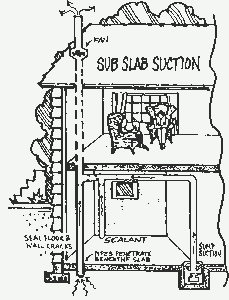What is the difference between passive and active radon control? This question is often asked since the Minnesota Department of public health announced the new radon initiatives, effective January 1, 2014.
Passive radon control simply means that radon gas developing beneath the floor of the basement will be transferred to the outside of the house by a three or 4 inch diameter plastic tube, without the aid of a fan. ABS, which is black plastic tubing or PVC, which is a white plastic tube, may be used in the system, but; the two are not to be joined together. Their chemical joining systems are not compatible.
The passive system can only be used in areas of the home that are heated because the means of getting the radon from under the basement floor system and out of the house, through the roof, relies on the natural effect of heated air rising. Passive systems are usually found in new construction because the house designer can create a simple flow path within the building structure from below the basement floor to 12 inches above the roof and; a passive system is all that is required under the IRC code, adopted in Minnesota. 
New home design in Minnesota, takes advantage of the code required drain tile system that surrounds the house. The drain tile usually drains into a floor sump where moisture gathers to be expelled to the outside via a sump pump. Most modern sumps have a sealable lid with provision to install the radon tube. The warmed air rising in the radon exhaust tube lowers the pressure in the entire drain tile system so directing all radon under the floor system to atmosphere without ever entering the home. The passive system, costing just a few hundred dollars, is a satisfactory system that cannot be said to be ideal in either new or existing construction.
The active system however, costing only a few hundred dollars extra, guarantees control of the gas flow from under the house footprint to atmosphere. The Minnesota Department of public health recommends the active system and calls it the gold standard. Active systems have a silent exhaust fan, that is usually installed either in the attic of the home or on the outside of the house where they can suck radon out without having to rely on the physics of heat rising or passing through the house structure. The precise amount of suction can be confirmed by a simple chemical filled plastic tube (costing about $12), called a manometer, that is installed on the radon tube, in a place where it can easily be observed. Discounted radon fans may be purchased at the Minnesota Department of public health to reduce the cost of the radon installation.
Rob ‘Pops’ Leslie MN
Home Inspection
Minneapolis & St. Paul
Kaplan Professionals (retired instructor)


